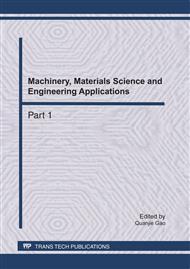p.580
p.586
p.592
p.597
p.601
p.605
p.610
p.617
p.621
Wear Behavior of B4C Ceramic Nozzles
Abstract:
B4C ceramic nozzle was produced by hot pressing, and wear behavior of the nozzle by SiC, white emery and umber emery abrasives were investigated, erosion wear mechanisms based on stress states analyzing with finite element method were studied. Results showed that the greater the hardness and grit size of abrasives, the more mess loss of the nozzle, the maximum stress appeared in entrance area of the nozzle and minimum stress in middle area, while the stress of exit area was lower than entrance area and higher than middle area. The nozzle exhibited a brittle fracture induced removal process in the entrance of the nozzle and a stress fatigue induced removal process in the middle of the nozzle under the condition of SiC abrasives impacting, and a stress fatigue induced removal process under white and umber emery abrasives impacting.
Info:
Periodical:
Pages:
601-604
Citation:
Online since:
April 2011
Authors:
Keywords:
Price:
Сopyright:
© 2011 Trans Tech Publications Ltd. All Rights Reserved
Share:
Citation:


